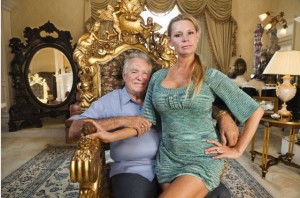
America Ferrera speaking with Urmi Batsu in ‘Half the Sky’ (via avclub.com)
Half the Sky is a documentary about women’s rights that focuses on women in “developing countries” (countries of the Global South). The film is inspired by Nicholas Kristof and Sheryl WuDunn’s nonfiction eponymous book. The film itself examines complex moral and cultural issues that are addressed by women from within the community who have experience with those issues. Half the Sky aired as two two-hour segments on PBS in the United States. While it mainly focuses on and features the women who are making change for other women within their own countries, the documentary also features Nicholas Kristof and several actresses (Diane Lane, America Ferrera, Olivia Wilde, Gabrielle Union, Eva Mendes, and Meg Ryan), as well as an appearance by George Clooney and many women’s rights advocates and activists. Some issues of violence against women examined in this documentary include rape in Sierra Leone, sex trafficking in Cambodia, maternal mortality and female genital cutting in Somaliland, and intergenerational prostitution in India.
While this documentary does quite a few things right, there are many issues with its presentation and execution. I will discuss these problems – with Kristof’s reporting, the representation of “global” or “worldwide” women, the inclusion of American celebrities, and the lack of male representation – before I talk about the positive aspects of Half the Sky.
In Half the Sky, Nicholas Kristof portrays himself as something of an Activist-Reporter. He creates a clear “us and them” dichotomy between (generally) white American women and the “worldwide” women of the Global South. Kristof’s continual discussion of “their culture” (my emphasis) demonstrates this dichotomy, especially when he claims that “[female genital cutting] may be [their] culture, but it’s also a pretty lousy aspect of culture.” Furthermore, Kristof unabashedly asks these women (and young girls) of the countries he is touring about the state of their genitals and their experiences as victims of rape; it is doubtful that he would ask these questions so publicly of white American women.
The inclusion of celebrities in this film is problematic. Kristof seems to think that these celebrities create a “bridge” for the presumed-typical white American viewer. While there may be something to be said for generating interest or support for an issue that obviously needs attention, taking female celebrities on what is essentially a poverty tour does not benefit the story Kristof should be telling. Perhaps these celebrities could have lent their star status in a different way (support through advertising, perhaps). Rather than contribute to the telling of individual cultural stories, the American celebrities highlight the dichotomy Kristof has created: sure, it may be aesthetically pleasing to watch Olivia Wilde dance with traditionally dressed Kenyan village women singing “the vagina song,” but there is no reason for that image to be an important moment in Half the Sky.
The portrayal of women of the Global South as “worldwide” women is another problematic topic within Half the Sky. These women are consistently portrayed as unloved, disrespected, and ignored by men. This portrayal only serves to further the “us/them” dichotomy. Additionally, men are not represented at all in Half the Sky. They are simply mentioned as careless, useless, brutal members of society who treat women with cruelty.
Finally, I want to point out some of the positive aspects of Half the Sky. Depicting women native to the countries being explored, women who have experienced the problems/horrors/issues that they are now fighting against, women who are part of the culture they are trying to bring change to? That is an extremely positive representation of women and of a solution for violence against them because that violence is being addressed by women who get it. They understand the culture, the atmosphere, the reasoning behind the actions. Seeing local women activists brings attention to the organizations that are truly fighting the problems in their native countries. While the “us/them” dichotomy in Half the Sky discourages the kind of global female empowerment and relationships that the film seems to attempting to encourage, the overall message is still a true one. Educating and empowering women improves the health of families, the strength of communities, and the growth (particularly economic) of nations.
Relevant, Interesting, and Informative Articles:
[1] “How Nicholas Kristof and Half the Sky Use Women Against Each Other” by Sayantani DasGupta on Racialicious
[2] “On the Ground: Westerners On White Horses…” by Nicholas D. Kristof on The New York Times Opinion Pages: Kristof’s Blog
[3] Half the Sky Documentary Reviewed by Azra on Patheos
[4] Information on the North-South Divide (Wikipedia)
[5] Half the Sky Information (PBS)
[6] Half the Sky Movement: Half the Sky Information
Julia Aversa

